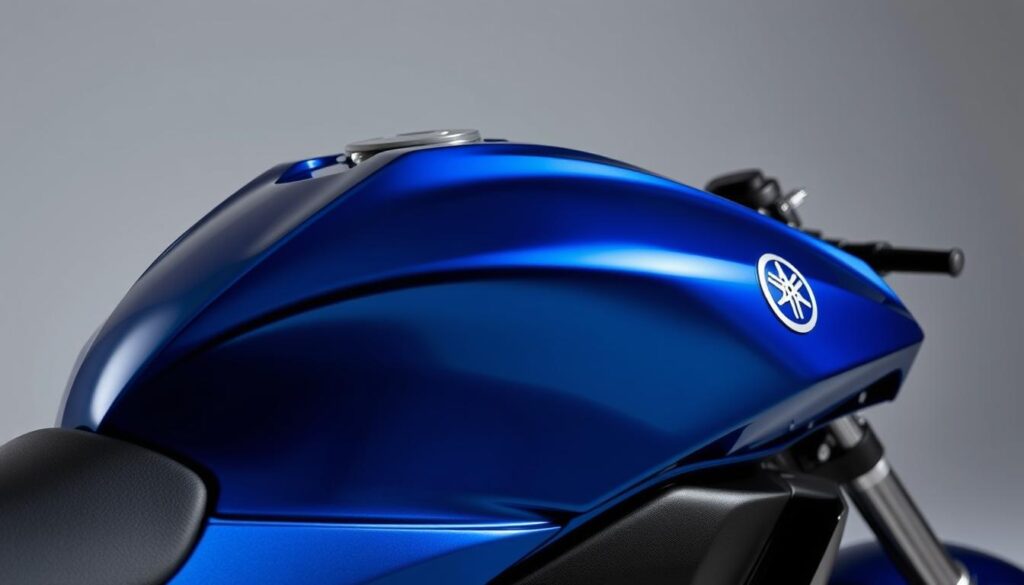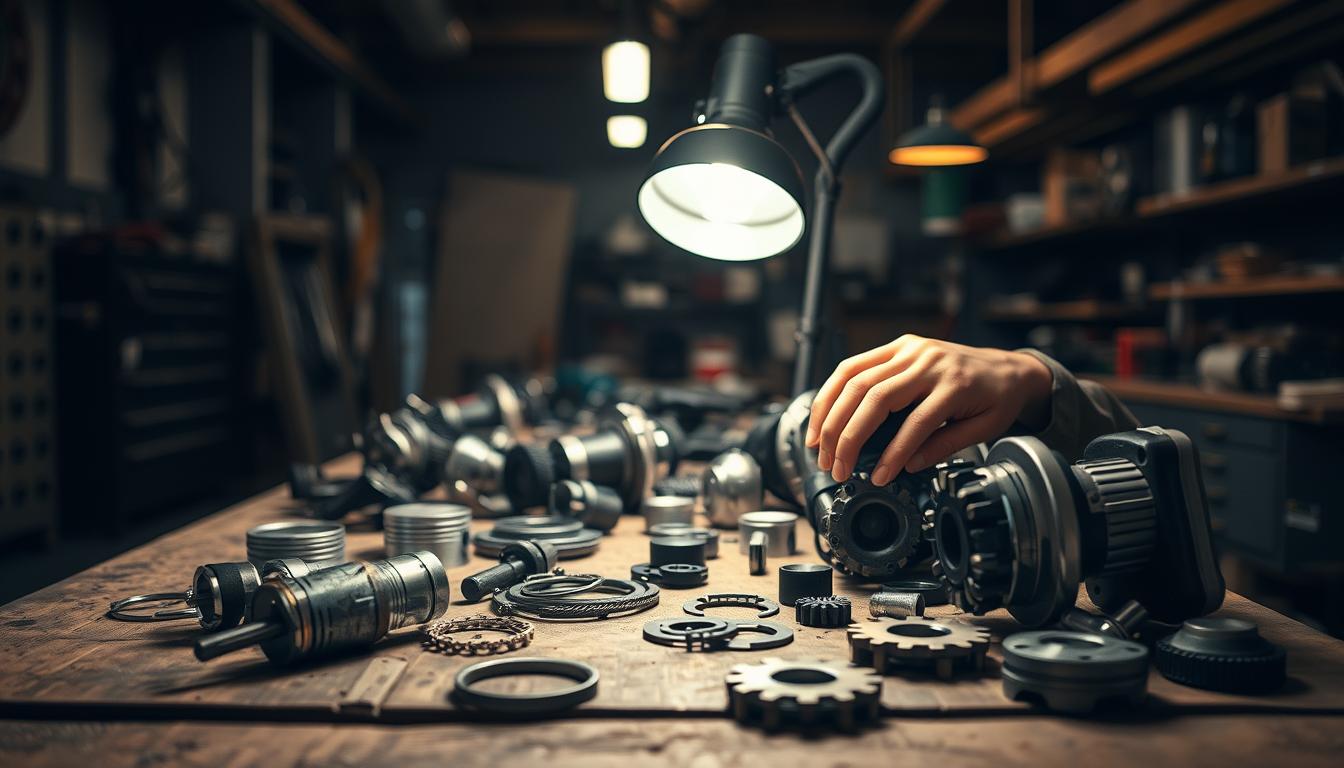Have you ever wondered what makes a fuel tank a perfect fit for your bike? Choosing the right one can be tricky, especially when you’re dealing with pre-owned parts. Whether you’re restoring a classic Yamaha or upgrading your Suzuki, understanding what to look for is crucial.
When inspecting a tank, start by checking for leaks, rust, or sediment. These issues can affect performance and safety. A clean, well-maintained tank ensures your bike runs smoothly. Don’t forget to examine the seals and hoses—they play a vital role in preventing fuel loss.
Brands like Honda, Kawasaki, and Yamaha often have unique designs. Make sure the tank matches your bike’s model and year. Compatibility is key to avoiding costly modifications. For more options, explore motorcycle fuel tanks to find the perfect fit.
Key Takeaways
- Inspect for leaks, rust, and sediment to ensure the tank’s condition.
- Check seals and hoses for wear to prevent fuel loss.
- Ensure compatibility with your bike’s make and model.
- Brand-specific designs may require careful matching.
- Explore trusted sources for a wide range of options.
Understanding Motorcycle Fuel Tank Requirements
A well-designed fuel tank combines style and performance seamlessly. Whether you’re restoring a classic Yamaha or upgrading your Suzuki, understanding the core requirements ensures you make the right choice. Let’s explore what makes a fuel tank both functional and visually appealing.
Functional and Aesthetic Considerations
When choosing a fuel tank, functionality is just as important as aesthetics. A well-designed tank not only looks good but also performs reliably. Ensure the tank matches your bike’s style and complements its overall design.
Consider the efficiency of sealing and the impact on aesthetic appeal. A properly sealed tank prevents leaks and ensures smooth operation. Look for features like a durable cap and high-quality rubber seals for added reliability.
Materials and Durability Insights
The choice of materials plays a crucial role in the tank’s durability. Most tanks are made of metal or blow-moulded plastic, each offering unique benefits. Metal tanks, like those from Honda or Kawasaki, are known for their strength and resistance to wear.
Plastic tanks, on the other hand, are lightweight and often feature integrated functions like refilling interfaces. OEM standards ensure these materials meet strict quality and durability requirements, making them a reliable choice for your bike.
- Match the tank’s design to your bike’s style for a cohesive look.
- Choose materials like metal or plastic based on your needs.
- Ensure proper sealing with high-quality rubber seals and caps.
- Opt for OEM-compliant tanks for guaranteed durability.
Key Features of High-Quality Fuel Tanks
Understanding the key features of a premium fuel tank can save you time and money. Whether you’re restoring a classic Yamaha or upgrading your Suzuki, knowing what to look for ensures you get the best value.

Material Composition and Rubber Seals
The materials used in a fuel tank play a significant role in its durability. Most premium tanks are made from high-grade metal or blow-moulded plastic. Metal tanks, like those from Yamaha or Honda, are known for their strength and resistance to wear.
Rubber seals are another critical component. They prevent leaks and ensure the tank remains airtight. High-quality seals, combined with a durable cap, enhance the tank’s lifespan and performance.
Performance and OEM Standards
When it comes to performance, OEM-compliant tanks are the gold standard. These tanks meet strict quality and durability requirements, ensuring they fit perfectly and function reliably. For example, Yamaha’s manufacturing process involves skilled craftsmanship and advanced technology to eliminate imperfections.
Proper sealing and robust design are crucial for high mileage. A well-built tank prevents leaks, reduces maintenance costs, and keeps your bike running smoothly for years.
- Choose materials like metal or plastic based on your needs.
- Ensure rubber seals and caps are high-quality for airtight performance.
- Opt for OEM-compliant tanks for guaranteed durability and fit.
- Look for craftsmanship details that prevent leaks and enhance longevity.
Used Motorcycle Fuel Tanks: Evaluating Quality
When buying a pre-owned fuel tank, quality evaluation is essential. A thorough inspection can help you avoid costly repairs and ensure your bike runs smoothly. Here’s what to look for when assessing a second-hand tank.
Assessing Leaks, Cracks, and Wear
Start by checking for visible damage. Look for leaks, cracks, or signs of wear. Even small cracks can lead to bigger problems over time. Rust is another red flag, especially in older models like Yamaha or Suzuki.
Inspect the interior for sediment or debris. These can clog your fuel system and affect performance. If the tank has been sitting unused, rust and sediment are more likely. A clean, well-maintained tank is a good sign of quality.
Importance of Filters, Pumps, and Hoses
Don’t overlook the filter, pump, and hose. These components are critical for proper fuel delivery. A damaged filter can allow contaminants into your engine, while a faulty pump can disrupt fuel flow.
Check the hoses for cracks or brittleness. Replace any worn-out parts to prevent leaks. Proper sealing is also crucial. Ensure the cap and seals are intact to avoid fuel wastage.
“A well-maintained fuel tank is the backbone of a reliable bike. Always inspect thoroughly before making a purchase.”
- Look for leaks, cracks, and rust to assess the tank’s condition.
- Inspect the interior for sediment or debris.
- Check the filter, pump, and hoses for wear and damage.
- Ensure the cap and seals are intact to prevent fuel loss.
- Opt for tanks from trusted brands like Yamaha or Honda for better reliability.
Brand Insights: Yamaha, Honda, Kawasaki, and Suzuki Options
Choosing the right fuel tank for your bike involves more than just compatibility. Brands like Yamaha, Honda, Kawasaki, and Suzuki each offer unique designs and features. Understanding these differences can help you make an informed decision.

Exploring OEM vs Aftermarket Choices
When it comes to fuel tanks, you have two main options: OEM (Original Equipment Manufacturer) and aftermarket parts. OEM tanks, like those from Yamaha or Honda, are designed specifically for your bike’s model. They meet strict quality standards and ensure a perfect fit.
Aftermarket alternatives, on the other hand, offer more variety and often come at a lower cost. However, they may not always match the durability or precision of OEM parts. Always weigh the pros and cons before making your choice.
Genuine Parts vs Third-Party Accessories
Genuine parts from brands like Kawasaki or Suzuki are built to last. They undergo rigorous testing to ensure reliability and performance. These parts often come with warranties, giving you peace of mind.
Third-party accessories can be tempting due to their affordability. While some are well-made, others may lack the quality control of genuine parts. Always check reviews and verify the manufacturer’s reputation before purchasing.
“Investing in genuine parts ensures your bike performs at its best. It’s a decision that pays off in the long run.”
- OEM tanks from Yamaha or Honda offer perfect fit and reliability.
- Aftermarket options provide variety but may compromise on quality.
- Genuine parts from Kawasaki or Suzuki ensure durability and performance.
- Third-party accessories can be cost-effective but require careful vetting.
- Always consider brand reputation and OEM standards when choosing a tank.
Practical Tips for Inspecting and Maintaining Fuel Tanks
Keeping your bike’s fuel system in top shape starts with proper inspection and maintenance. A well-maintained fuel tank ensures your bike runs smoothly and avoids costly repairs. Here’s how you can keep it in great condition.

Inspecting for Cracks, Seals, and Caps
Start by checking for visible cracks or damage. Even small cracks can lead to bigger issues over time. Inspect the seals and cap to ensure they’re intact and functioning properly. A damaged seal can cause leaks, while a faulty cap can lead to fuel evaporation.
Look for signs of rust or sediment inside the tank. These can clog your fuel system and affect performance. If you spot any debris, clean the tank thoroughly to prevent further issues.
Maintenance Routines for Extended Lifespan
Regular cleaning is essential to keep your fuel tank in good condition. Use a high-quality cleaner to remove any buildup. Replace the filter periodically to ensure proper fuel flow and reduce strain on the pump.
Check the hose and other components for wear and tear. Replace any damaged parts promptly to avoid leaks or fuel loss. Proper maintenance not only extends the lifespan of your tank but also ensures your bike’s safety and performance.
“A well-maintained fuel system is the backbone of a reliable bike. Regular checks and timely replacements can save you from costly repairs.”
- Inspect for cracks, rust, and sediment to ensure the tank’s condition.
- Check seals and caps for wear to prevent leaks and evaporation.
- Clean the tank regularly and replace the filter as needed.
- Monitor hoses and other components for damage.
- Follow a maintenance routine to extend the tank’s lifespan.
Shopping Smart: Sourcing Quality Fuel Tanks and Accessories
Finding the right fuel tank for your bike doesn’t have to be overwhelming. With the right strategies, you can source high-quality parts and accessories without breaking the bank. Here’s how to shop smart and make informed decisions.
Using Online Reviews and Trusted Stores
Start by checking online reviews. Platforms like Google Trusted Stores provide valuable feedback from real customers. Look for comments about product quality, shipping speed, and customer service. This helps you identify reliable sellers.
Stick to trusted stores with a proven track record. Brands like Yamaha and Honda often have official retailers that guarantee authenticity. Avoid unknown sellers, especially if the deal seems too good to be true.

Checking Prices, Warranty, and Shipping Options in Australia
Compare prices across multiple platforms. Some stores offer discounts on specific models, like the Boab Poly Diesel Tank, which can save you up to $46. Always check the warranty terms to ensure your purchase is protected.
Shipping options are another key factor. Many Australian stores, like Adventure Moto, now ship globally. Look for local shops that offer fast and affordable delivery within Australia.
Leveraging Afterpay and Local Shop Benefits
If you’re on a budget, consider using Afterpay. This payment method allows you to split your purchase into four equal instalments. It’s a great way to manage expenses without delaying your project.
Local shops often provide additional benefits, like personalised advice and faster returns. Supporting local businesses also strengthens the community and ensures you get genuine parts.
“Shopping smart means doing your research and choosing trusted sources. It’s the best way to ensure you get quality parts at a fair price.”
- Check online reviews and stick to trusted stores for reliable purchases.
- Compare prices, warranty terms, and shipping options to find the best deal.
- Use Afterpay to manage your budget and split payments into instalments.
- Leverage local shop benefits for personalised service and faster returns.
- Always prioritise quality and authenticity over the lowest price.
Conclusion
Making the right choice for your bike’s essential components ensures long-term performance and reliability. From inspecting for cracks and rust to checking seals and hoses, thorough evaluations are crucial. Brands like Yamaha and others offer reliable options, but always verify compatibility and quality.
Regular maintenance, such as cleaning and replacing the filter, extends the lifespan of your tank. When sourcing parts, rely on trusted stores and reviews to avoid subpar products. Combining expert advice with detailed research ensures you make informed decisions.
By following these practical tips, you’ll enhance your bike’s performance and enjoy a smoother ride. Prioritize quality and compatibility to get the most out of your investment.




